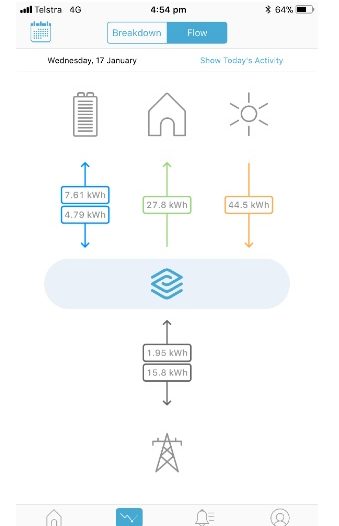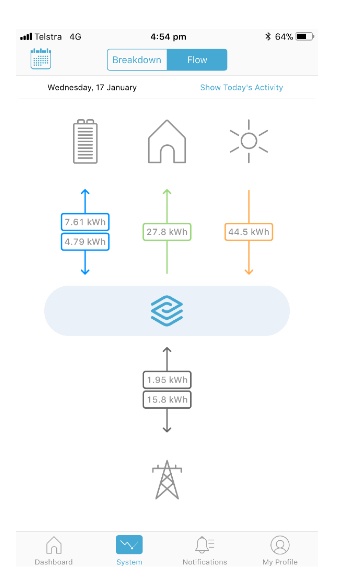
I just earned $1 for selling 1kWh back into the grid.
Actually, I just earned $3.20 from selling half the storage in my Tesla Powerwall 1 during a ‘Grid Event’ back on 7 March, which brought my daily earnings from selling back into the grid to $5.62.
Not exactly a lottery win, but not to be sneezed at. Plus, I had the satisfaction of being part of the growing number of households who are helping to keep the lights on in suburbs when the grid is in trouble or when the spot price is unstable.
It was only the second “grid event” to impact Canberra this summer (last time was in November 30), but it’s something I am banking on happening more before they fix the east coast grid and/or Canberra goes 100% renewable in 2020.
It’s like betting against the economy, but with energy.

Doubling down
But I didn’t just bet against Canberra’s high growth in electricity prices (albeit off the lowest base) and the likelihood of black outs.
This was an effort to shore up the rising cost of living tide in the nation’s Capital – rates, gas, electricity, petrol, interest rates all going up with only a 3 per cent real increase in my salary (most Federal Public Servants don’t even get that).
So in December 2016 I went against the ROI-fixated ‘Solar-First Batteries-Second’ old hands and became part of Canberra’s Virtual Big Battery – a partnership between Reposit and the local ACTewAGL energy company – and spent $17,500 on an install that included:
- 6.5kWp system with 25 Jinko JKMS 260P modules (10 North, 15 West facing)
- 5kW SolarEdge SE5000 inverter;
- Tesla Powerwall and its 6.3kW of usable storage (for $5000 after the ACT Government subsidy); and
- Reposit monitoring and optimising software, and Virtual Big Battery GridCredits
- (Black Out coverage added later in 2017)
Positives
- $32 average per month energy bill
- GridCredits
- Black Out coverage
After 12 months, I am happy to report that my 25 panel solar array and medium sized battery set-up (together some better demand management) has meant my wife and I have cut our electricity bill down from $2,100 per annum to just under $32 average per month (~$384 per annum).

Even though I own a pool and have a Carrier Heat Pump from last century (think 13kW draw when I use the element), my power bill is now the only bill I eagerly await – landing a $20 in credit in spring.
In summer my best day generated 44.5kWh in the nation’s capital:

I am now a full solar zealot and will tell anyone who will listen that the sun puts out these things called photons and that solar panels capture these photons and an inverter turns it into usable power for my household, the grid and my battery.
Plus I am an avid listener to the Energy Insiders and Solar Insiders poddies, and I trawl the Crap Solar Facebook page.
Negatives
- getting clipped
- checking my Reposit and SolarEdge app way too much (who doesn’t?) and at weird times (see the 10:46pm on GridCredits screenshots)
- the look on my wife’s face when I mention solar
Loss is the most powerful human emotion – measured at four times that of happiness. Seriously.
And although I know that it all works out the same in the end according to this ‘oversizing’ Solar Quotes article by Finn Peacock, it just irks me to see my SolarEdge clipped at 5kW on those hot windy summer days.

That is, unless the battery is still charging and then my system will produce up closer to near the 6.5kW maximum. See the 5.7 kW peak when the battery was still charging (orange chart below).

And how many times do I check my Reposit app? Well, suffice to say they should hand out free marriage counselling with every app, as I have been known to monitor the system and send my wife a text asking her if she is using the oven.
‘Tipping point’
Many are holding off, but I wanted to get in and see how it all works.
The ACT government’s $3,000 subsidy meant I bought the T1 at what some experts are calling the ‘tipping point’ of approximately $700 per kW of storage. Again, these are the same experts who are calling batteries a financial chimera and only applying the ‘payback period’ cost benefit analysis.
But there is one economic principle you can’t avoid – opportunity cost.
To fit the battery in to my budget I eschewed the premium LG 320 watt panels – forgoing the extra 11c feed-in tariff earnings from these more powerful panels – for betting against the network and a desire to be part of Reposit’s Virtual Big Battery solution.
Plus, I just dug the idea of sitting here at night with everything powered from my Powerwall.
The right installer
I still don’t get how energy moves through powerlines, or how Wi-Fi works, but I just know it does. So I leveraged outside expertise and got my three solar quotes, spoke to friends with solar and chose an installer who did a site inspection and has a local shopfront.
And I reckon I got it mostly right by going with these two trade-offs:
- short termism and focused on the quicker ROI with the greater value for money Jinkos, instead of the LG Neon 320s (which will generate more over the longer term);
- the tariff shifting battery over the higher power, premium panels – charging my battery during lower cost off-peak and gambling that FiTs don’t go through the roof (especially in the peak late afternoon period).
What’s next for the future sailor?
Yes, more is better. But as much as I want to bathe my roof in modules and slap up more batteries, I want to optimise what I already have.
I’m a more educated urban energy prosumer – one that both consumes and produces energy. Gone are days of me accepting the best ‘off-the-shelf’ energy bundle I could buy – with their time limited discounts and lack of customer service.
Now I want an Expert Battery, not just a Smart Battery; a battery that cycles twice a day and off-peak charges according to the BoM weather and my own usage patterns and equipment – and one that does this more consistently.
This means Reposit writing a better algorithm and having the time to tailor it to my household – which requires economies of scale.
Hopefully the crowd can help provide this scale-up, with DC Power spruiking the power of collective bargaining to improve service offerings and deliver a ‘VIP experience’ for prosumers.
So my next step has been to register my interest in DC Power’s crowd funded ‘Solar-As-A-Service’ offering to squeeze more out of my solar system.
That and I will use some of my GridCredits to appease the ROI Gods and swap out my pre-historic Carrier Heat Pump and switch my gas hot water over.
Then I will start future proofing again by buzzarding the electric vehicle market to find my ‘second battery’ – because those Texas oil fields aren’t filling up again any time soon.
Roger Rooney is an author and a Smart City technologist who is into his second year of living with battery augmented rooftop solar.

